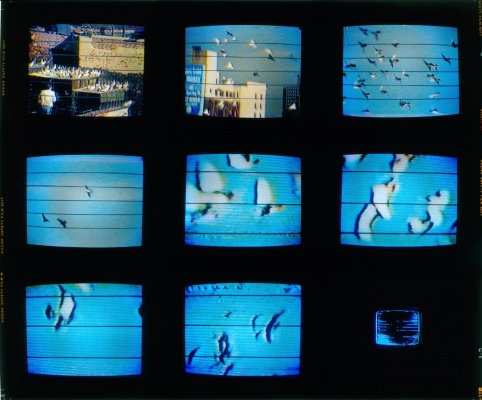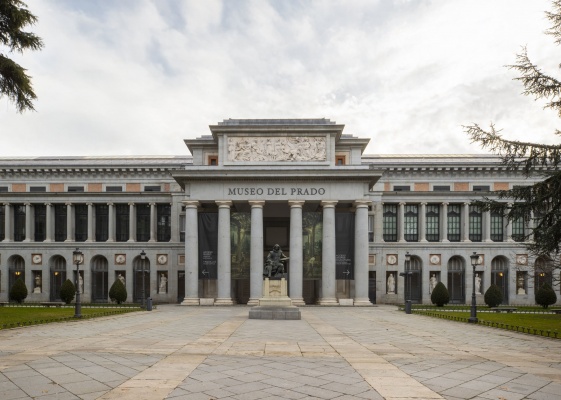Descripción de la Exposición
Inspired on John Cage’s ideas and his imaginary landscapes, this work explores the visual, third and four dimensions (space and time) of experienced musicality, providing and playing with the sound sources. The exhibition displays ensembles in brass and steel, sound and mixed media pieces. Once describing the roots of the sound sources, then becoming a loop, they bring to life fragments of memory through sound. The here and now is intervened. Silences build also punctuations, that on the trajectory of time are bridging the gaps. A forgotten part, a white spot, making us aware of our human defence mechanisms, to remember little glories of the past, to forget them, to continue and to trust.
Inspiriert von John Cages Ideen und seinen imaginären Landschaften, erforscht dieses Werk die visuelle, dritte und vierte Dimension (Raum und Zeit) der erlebten Musikalität, indem es Klangquellen bereitstellt und mit ihnen spielt. Die Ausstellung zeigt Ensembles aus Messing und Stahl, Klang -und Mischtechniken. Einmal die Wurzeln der Klangquellen beschreibend, dann zu einer Schleife werdend, erwecken sie Erinnerungsfragmente durch Klang zum Leben. Es wird in das Hier und Jetzt eingegriffen. Stille bildet auch Interpunktionen, die auf dem Weg der Zeit die Lücken überbrücken. Ein vergessener Teil, ein weißer Spot, der uns unsere menschlichen Abwehrmechanismen vor Augen führt, um sich an die kleine Herrlichkeit der Vergangenheit zu erinnern, sie zu vergessen, weiterzumachen und zu vertrauen.
Inspirada en las ideas de John Cage y sus paisajes imaginarios, esta obra explora la dimensión visual y la la tercera y cuarta dimensión (espacio y tiempo) de la musicalidad experimentada al proporcionar y jugar con fuentes sonoras. La exposición muestra conjuntos realizados en latón y acero, sonido y técnicas mixtas. Una vez que describen las raíces de las fuentes de sonido, luego se convierten en un bucle, dan vida a fragmentos de memoria a través del sonido. Interviene en el aquí y ahora. El silencio también forma una puntuación que cierra las brechas en el camino del tiempo. Una parte olvidada, un punto blanco que nos recuerda nuestros humanos mecanismos de defensa para recordar las pequeñas glorias del pasado, para olvidarlas, para seguir adelante y confiar.
--
Opening: Do. 23.6.2022, 19:00h
Intervention live Super Flumina Babylonis /// Denis Cardinaux
Exhibition: 23.6.-1.7.2022, 16:30-19:00h
Thursday 30.6., 19:00h
Duba Duba /// Liliana Arreola, Juliana Herrero:
Sopran Liliana Arreola -over the composition “Equilibrio” Fragmentos de Cantos de la Tierra by Galia Mirscha (text and music)
Fragments on piano by Barbara Probst. Assemble - performance JH
Super Flumina Babilonis /// Denis Cardinaux:
Intervention live -the manuscript used is from the 12th century: (Einsiedeln 121)
"How can we sing a song of Zion in a foreign land?" Evoking the exile on the banks of the river of Babylonia, the vocal gesture follows the lines and loops of the neumas of the medieval manuscripts, and seeks to find the echo of an interior geography.
Interpretar un ofertorio, probablemente del siglo 8, requiere hacer el camino desde la lineas y bucles de los antiguos reumas (el manuscrito utilizado es del siglo: (Einsiedeln 121), hasta el gesto vocal que dio origen a este modo tan estético y sensible de notar la música. Es un viaje entre el signo visual arcaico y el sonido que invita a encontrar el lugar interior donde ocurre el acto sagrado de cantar. Los signos visuales del manuscrito, tal como la instalación de Juliana Herrero indican una dirección y una energía en una geografía por descubrir. El salmo es el canto del exilio en Babylonia. Los judios cantaban a la orilla del río : « como podemos cantar un canto de Sion en tierra extranjera ». DC

Exposición. 08 may de 2025 - 14 sep de 2025 / MNAC - Museu Nacional d'Art de Catalunya / Barcelona, España

Formación. 30 oct de 2025 - 11 jun de 2026 / Museo Nacional del Prado / Madrid, España